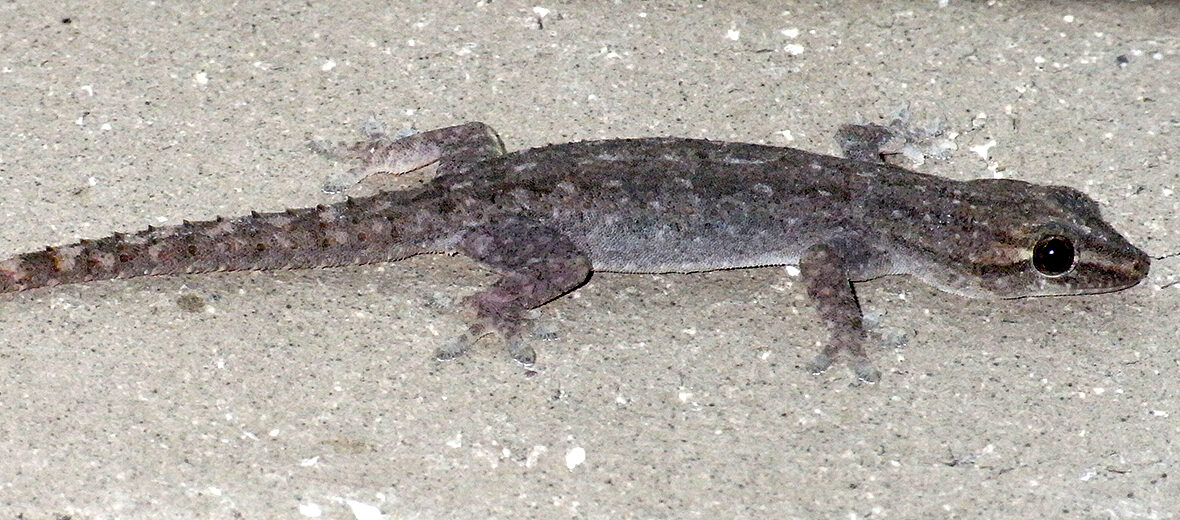
The dubious dtella, aka dubious four-clawed gecko, common house gecko, or native Australian house gecko, hails from northern New South Wales, Queensland, some islands of the Great Barrier Reef, and the Torres Strait. These geckos may face the threats of habitat loss and invasive species, and with them predation, but they are very adaptable and abundant. The IUCN lists these critters as Least Concern. Their population trend is unknown.
First the Stats…
Scientific name: Gehyra dubia
Weight: Up to .10+ ounce
Length: Up to 2.36 inches, plus up to a 5.51 inch tail
Lifespan: Up to 10+ years
Now on to the Facts!
1.) They can tolerate a range of habitats, such as acacia woodlands, eucalyptus woodlands, and in human-developed habitats, like house walls in urban areas.
2.) Seeing as these geckos have no eyelids, they will lick their eyes with their tongues rather than blinking in order to clean them.
3.) Like other gecko species, the dubious dtella is capable of caudal autonomy (they can drop their tail).
4.) Dubious dtellas are nocturnal (active at night), like most geckos.
5.) Their eyes are up to 350 times more sensitive than a human’s in the dark.
But wait, there’s more on the dubious dtella!
6.) Beetles, cockroaches, scorpions, and spiders make up the bulk of their diet, with nectar and sap being occasionally supplemented.
7.) Dtellas are arboreal (spend their lives in trees and/or shrubs), and can climb vertical surfaces with ease, due to their adhesive toe pads.
Did you know…?
Most geckos have tiny microscopic hairs called setae. Each seta splits off into 100s of even smaller bristles called spatulae. These tufts of tiny hairs get so close to the contours in walls and ceilings that the van der Waals force kicks in. This type of physical bond occurs when electrons from the gecko’s hair molecules and electrons from the wall molecules interact with each other and cause an electromagnetic attraction.
8.) Territoriality is displayed in the form of biting, chasing, and clawing one another.
9.) Their chirping calls are not typically audible to human ears. Their calls are also altered based on competitor, potential mate, or predator encounters.
10.) Thermoregulation (regulating body heat) is conducted by nestling up to houses, warm rocks, and trees to gain warmth. However, with the continuation of climate change, these geckos are shifting their activities to avoid lethal exposures to the high temperature during the day.
But wait, there’s still more on the dubious dtella!
11.) Their primary predators are snakes, such as the Death Adder, brown tree snake, Collette’s snake, and spotted pythons. Cats and birds also prey on these geckos while basking out in the open.
12.) They rely heavily on their superb eye sight to sense and subsequently avoid predators instead of primarily using their sense of smell.
Did you know…?
Even though these critters keep insect and arachnid populations at bay, they can sometimes cause havoc in homes by knocking over household items and even shorting out electrical wiring. Thus, they are considered a household pest and are, sadly, often killed.
13.) These geckos are oviparous (reproduce by laying eggs).
14.) Females lay a clutch of 2 eggs that hatch in up to 40 days.
15.) Hatchling geckos are precocial (totally self sufficient) and there is no parental care.
Be sure to share & comment below! Also, check out the Critter Science YouTube channel. Videos added regularly!
Want to suggest a critter for me to write about? Let me know here.
Some source material acquired from: Wikipedia & IUCN
Photo credit: Quartl




